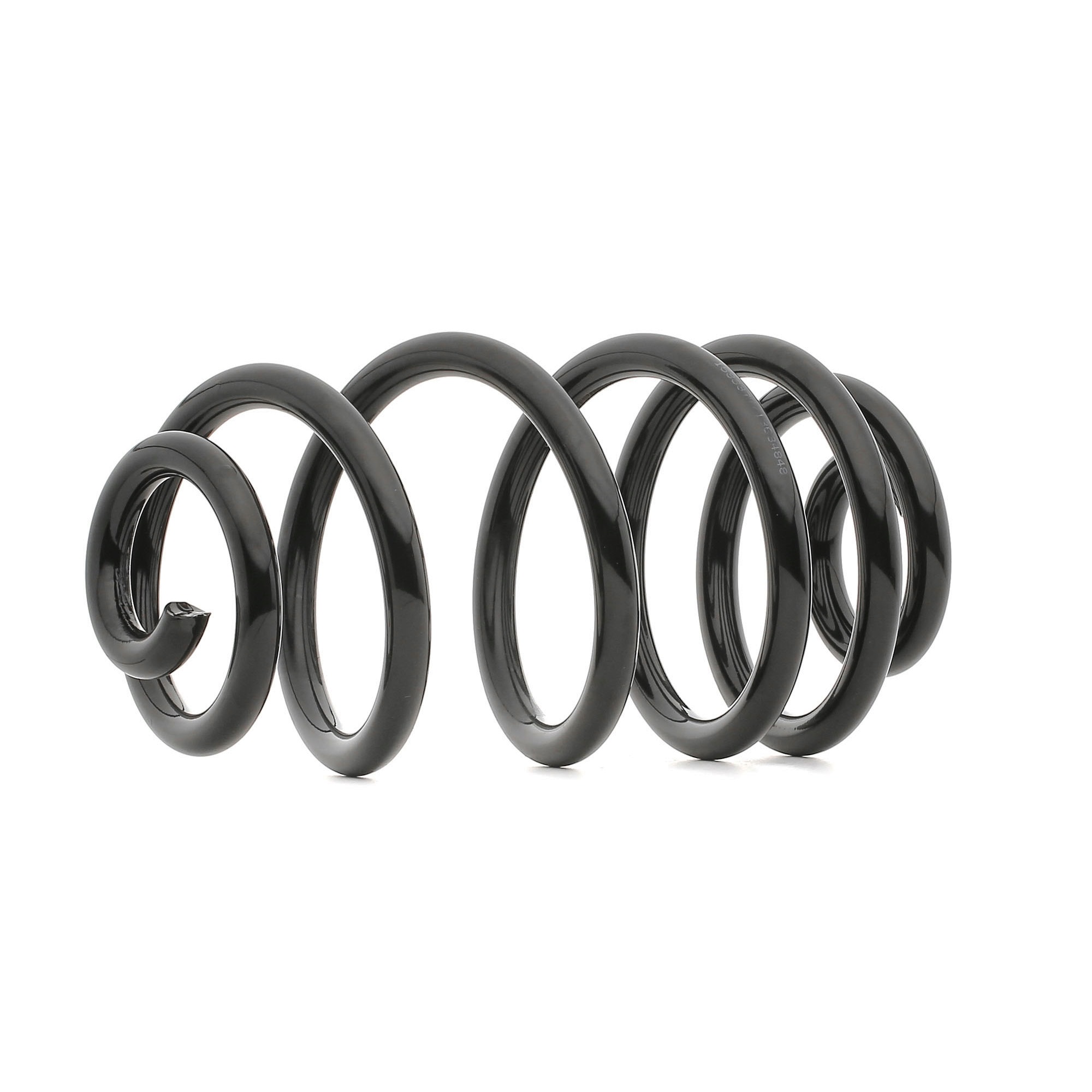Actual offers of Springs OPEL Insignia A Sports Tourer (G09) 2.0 CDTI 140 hp Diesel A 20 DTE
Der Preis war einfach super!!!
- Fitting Position: Rear Axle
- Length [mm]: 307
- Spring Design: Coil spring with constant wire diameter
- Diameter [mm]: 137
- Wire Diameter 1 [mm]: 15,5
- Item number: 188C0396
- Manufacturer: RIDEX
- Reference number OEM: 13276205, 13276204, 424140
- Condition: New
RRP is the recommended retail price set by the manufacturer or importer of the product and provided by the manufacturer, supplier or retailer. AUTODOC displays the RRP (VAT incl.) for a product if it has been received from at least one supplier or another source that has such information.
price incl. 19% VAT
excl. delivery costs
- Fitting Position: Front Axle
- Spring Design: Coil Spring
- Replace in pairs only
- Item number: 14.774.547
- Manufacturer: CS Germany
- Reference number OEM: 13260272, 312406, 312431
- Condition: New
RRP is the recommended retail price set by the manufacturer or importer of the product and provided by the manufacturer, supplier or retailer. AUTODOC displays the RRP (VAT incl.) for a product if it has been received from at least one supplier or another source that has such information.
price incl. 19% VAT
excl. delivery costs
- Fitting Position: Front Axle
- Spring Design: Coil Spring
- Trim Level: EcoFlex
- Replace in pairs only
- Item number: 14.774.562
- Manufacturer: CS Germany
- Reference number OEM: 312423, 12822721
- Condition: New
RRP is the recommended retail price set by the manufacturer or importer of the product and provided by the manufacturer, supplier or retailer. AUTODOC displays the RRP (VAT incl.) for a product if it has been received from at least one supplier or another source that has such information.
price incl. 19% VAT
excl. delivery costs
- Fitting Position: Rear Axle
- Suspension: for vehicles with lowered suspension
- Item number: ZCA7029A
- Manufacturer: ASHIKA
- Reference number OEM: 424524, 13310864, 13310867
- Condition: New
- Fitting Position: Rear Axle
- Spring Design: Coil Spring
- Parameter: E
- Item number: SX192MT
- Manufacturer: Magnum Technology
- Reference number OEM: 4 24 141, 4 24 184, 4 24 142
- Condition: New
-
- Fitting Position: Front Axle
- Suspension: for vehicles with standard suspension
- Vehicle Identification Number (VIN) from: E1000001
- Transmission Type: Manual Transmission
- Trim Level: ecoFlex
- Length [mm]: 338
- Diameter [mm]: 153, 13,25
- Parameter: white AAHA, white AAHB
- Item number: 71723
- Manufacturer: MAPCO
- Reference number OEM: 22879059, 22879058, 3 12 627
- Condition: New
RRP is the recommended retail price set by the manufacturer or importer of the product and provided by the manufacturer, supplier or retailer. AUTODOC displays the RRP (VAT incl.) for a product if it has been received from at least one supplier or another source that has such information.
price incl. 19% VAT
excl. delivery costs
- Fitting Position: Rear Axle
- Spring Design: Coil Spring
- Parameter: E
- Item number: 60-0966
- Manufacturer: MAXGEAR
- Reference number OEM: 424237, 13322083
- Condition: New
-
- Fitting Position: Rear Axle
- Suspension: for vehicles with sports suspension
- Length [mm]: 295
- Spring Design: Coil spring with constant wire diameter
- Weight [kg]: 3,430
- Packaging length [cm]: 16,8
- Packaging width [cm]: 16,7
- Packaging height [cm]: 40,6
- Customs tariff number: 73202089
- Item number: SN3994
- Manufacturer: MONROE
- EAN number: 5412096503986
- Condition: New
RRP is the recommended retail price set by the manufacturer or importer of the product and provided by the manufacturer, supplier or retailer. AUTODOC displays the RRP (VAT incl.) for a product if it has been received from at least one supplier or another source that has such information.
price incl. 19% VAT
excl. delivery costs
Günstig ist alles andere Anbieter
- Fitting Position: Rear Axle
- Spring Design: Coil spring with constant wire diameter
- Vehicle Equipment: for vehicles with leveling control
- Replace in pairs only
- Item number: 14.774.494
- Manufacturer: CS Germany
- EAN number: 4047297184941
- Condition: New
RRP is the recommended retail price set by the manufacturer or importer of the product and provided by the manufacturer, supplier or retailer. AUTODOC displays the RRP (VAT incl.) for a product if it has been received from at least one supplier or another source that has such information.
price incl. 19% VAT
excl. delivery costs
- Fitting Position: Rear Axle
- Production Number: K4031537
- Item number: 4031537
- Manufacturer: KRAFT
- Reference number OEM: 13302432
- Condition: New
- Fitting Position: Rear Axle
- Suspension: for vehicles with lowered suspension
- Item number: ZCA7026A
- Manufacturer: ASHIKA
- Reference number OEM: 13276206, 13312083, 13310869
- Condition: New
Super zufrieden.
- Product line: K-Flex
- Fitting Position: Front Axle
- Suspension: for vehicles with lowered suspension
- Spring Design: Coil Spring
- Parameter: E
- Item number: RA3977
- Manufacturer: KYB
- Reference number OEM: 13260275, 312597, 22879060
- Condition: New
RRP is the recommended retail price set by the manufacturer or importer of the product and provided by the manufacturer, supplier or retailer. AUTODOC displays the RRP (VAT incl.) for a product if it has been received from at least one supplier or another source that has such information.
price incl. 19% VAT
excl. delivery costs
- Product line: K-Flex
- Fitting Position: Front Axle
- Suspension 0
- Spring Design: Coil Spring
- Parameter: E
- Item number: RA3976
- Manufacturer: KYB
- Reference number OEM: 312389, 13219116, 13260296
- Condition: New
RRP is the recommended retail price set by the manufacturer or importer of the product and provided by the manufacturer, supplier or retailer. AUTODOC displays the RRP (VAT incl.) for a product if it has been received from at least one supplier or another source that has such information.
price incl. 19% VAT
excl. delivery costs
- Fitting Position: Rear Axle
- Suspension: for vehicles with lowered suspension
- Spring Design: Coil spring with constant wire diameter
- Trim Level: Ecoflex
- Item number: 4263506
- Manufacturer: LESJÖFORS
- Reference number OEM: 32055421
- Condition: New
RRP is the recommended retail price set by the manufacturer or importer of the product and provided by the manufacturer, supplier or retailer. AUTODOC displays the RRP (VAT incl.) for a product if it has been received from at least one supplier or another source that has such information.
price incl. 19% VAT
excl. delivery costs
-
- Fitting Position: Rear Axle
- Suspension: for vehicles with height-adjustable suspension
- Length [mm]: 270
- Spring Design: Mini Block, Coil spring with inconstant wire diameter
- Weight [kg]: 2,980
- Packaging length [cm]: 16,8
- Packaging width [cm]: 16,7
- Packaging height [cm]: 40,6
- Wire Diameter [mm]: 14,8
- Item number: SP3991
- Manufacturer: MONROE
- EAN number: 5412096503887
- Condition: New
RRP is the recommended retail price set by the manufacturer or importer of the product and provided by the manufacturer, supplier or retailer. AUTODOC displays the RRP (VAT incl.) for a product if it has been received from at least one supplier or another source that has such information.
price incl. 19% VAT
excl. delivery costs
- Fitting Position: Rear Axle
- Spring Design: Coil spring with constant wire diameter
- Item number: 4263500
- Manufacturer: LESJÖFORS
- Reference number OEM: 13312084
- Condition: New
RRP is the recommended retail price set by the manufacturer or importer of the product and provided by the manufacturer, supplier or retailer. AUTODOC displays the RRP (VAT incl.) for a product if it has been received from at least one supplier or another source that has such information.
price incl. 19% VAT
excl. delivery costs
-
- Trim Level: Ecoflex
- Suspension: for vehicles with lowered suspension
-
- Suspension 0
- Fitting Position: Rear Axle
- Spring Design: Coil Spring
- Item number: RA5164
- Manufacturer: KYB
- EAN number: 4549762253461
- Condition: New
- Fitting Position: Front Axle
- Spring Design: Coil Spring
- Item number: 4063534
- Manufacturer: LESJÖFORS
- EAN number: 4063534
- Condition: New
RRP is the recommended retail price set by the manufacturer or importer of the product and provided by the manufacturer, supplier or retailer. AUTODOC displays the RRP (VAT incl.) for a product if it has been received from at least one supplier or another source that has such information.
price incl. 19% VAT
excl. delivery costs
- Product line: K-Flex
- Fitting Position: Rear Axle
- Spring Design: Coil Spring
- Parameter: E
- Vehicle Equipment: for vehicles with leveling control
- Item number: RA7028
- Manufacturer: KYB
- EAN number: 4909500914748
- Condition: New
RRP is the recommended retail price set by the manufacturer or importer of the product and provided by the manufacturer, supplier or retailer. AUTODOC displays the RRP (VAT incl.) for a product if it has been received from at least one supplier or another source that has such information.
price incl. 19% VAT
excl. delivery costs
- Fitting Position: Rear Axle
- Length [mm]: 302
- Spring Design: Coil spring with constant wire diameter
- Number of coils: 7
- Check OE number
- replacement in pairs recommended
- Wire Diameter [mm]: 14,2
- Item number: R10350
- Manufacturer: EIBACH
- EAN number: 4050278087070
- Condition: New
RRP is the recommended retail price set by the manufacturer or importer of the product and provided by the manufacturer, supplier or retailer. AUTODOC displays the RRP (VAT incl.) for a product if it has been received from at least one supplier or another source that has such information.
price incl. 19% VAT
excl. delivery costs
- 1
- 2
- 3
- 4




























